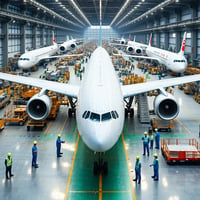China’s Growing Aviation Manufacturing Industry and Its Implications for U.S. Manufacturing China...
The Decline of U.S. Jet Manufacturing: Quality Issues, Global Competition, and National Security Risks
The Decline of U.S. Jet Manufacturing: Quality Issues, Global Competition, and National Security Risks
For decades, the United States dominated the global jet manufacturing industry. American companies set the standard for innovation, reliability, and performance in both commercial and military aviation. However, a combination of quality control failures, rising foreign competition, and strategic missteps has eroded this dominance. The consequences of this decline go beyond economic concerns—they pose significant risks to national security.
The Erosion of U.S. Leadership in Commercial Aviation
Boeing was once the gold standard in commercial aviation, producing industry-defining aircraft such as the 747, 777, and 787. However, recent years have been marked by serious quality control failures, supply chain disruptions, and strategic blunders. The 737 MAX crisis exposed critical flaws in design and oversight, leading to tragic crashes and global regulatory scrutiny. More recently, quality issues with the 787 Dreamliner and 777X have further damaged Boeing’s reputation, eroding customer confidence.
Meanwhile, foreign competitors have capitalized on these weaknesses. Airbus has steadily gained market share, with its A320neo family outselling the 737 MAX and the A350 surpassing the 787 in global orders. Even more concerning, China’s COMAC C919 has entered the market with strong government backing. While still technologically inferior to Western aircraft, its development represents a long-term challenge, particularly as China continues to expand its aerospace capabilities.
Compounding the issue is the U.S. aviation supply chain’s reliance on foreign components. The globalization of manufacturing has made aircraft assembly more vulnerable to disruptions, especially in times of geopolitical tension. If critical parts are produced abroad, it raises concerns about availability, reliability, and potential foreign influence over the production process.
Military Jet Manufacturing Faces Similar Challenges
The decline in U.S. aerospace manufacturing is not limited to commercial aviation. Military aircraft programs have also faced severe setbacks, cost overruns, and performance issues. The F-35 Joint Strike Fighter, meant to be the cornerstone of U.S. air superiority, has suffered from years of production delays, software glitches, and maintenance challenges. Meanwhile, the Air Force’s next-generation fighter program (NGAD) faces uncertain development timelines and high costs, potentially leaving gaps in U.S. airpower.
The situation extends beyond fighter jets. The KC-46 Pegasus tanker program has been plagued by defects, while the B-21 Raider stealth bomber remains an unproven platform with unknown reliability. These issues raise concerns about the U.S. military’s ability to sustain a technological edge in air combat.
Compounding these problems is the outsourcing of manufacturing and reliance on foreign supply chains. Many critical components for military aircraft—including electronics and rare earth materials—are sourced from countries that may not align with U.S. strategic interests. In the event of a global conflict or trade war, access to these materials could be restricted, creating serious vulnerabilities.
The National Security Implications
The decline of U.S. jet manufacturing carries significant national security risks. A weakened domestic aerospace industry makes the country more dependent on foreign suppliers, increasing vulnerability in times of crisis. The ability to rapidly produce, maintain, and upgrade military aircraft is a fundamental component of national defense. If production capabilities continue to erode, it could leave the U.S. military struggling to maintain technological superiority over adversaries.
Furthermore, a shrinking aerospace workforce means a loss of critical expertise. As manufacturing shifts overseas or declines domestically, fewer engineers, technicians, and skilled workers are available to maintain and develop future aircraft. This brain drain weakens long-term innovation and competitiveness in the industry.
The rise of foreign competitors, particularly China, introduces another layer of concern. While Airbus is a longtime rival, it operates within the framework of Western alliances. China’s COMAC, however, is state-backed and tied to a regime with clear geopolitical ambitions. If COMAC succeeds in breaking into the global market, it could shift the balance of power in aviation, allowing China to influence aircraft supply chains, maintenance networks, and international regulations.
Reversing the Decline
If the U.S. is to reclaim its leadership in jet manufacturing, significant changes are needed. Boeing and other aerospace manufacturers must prioritize quality control, innovation, and long-term planning over short-term financial gains. The government should consider policies that incentivize domestic production and reduce reliance on foreign suppliers, particularly for military aircraft components.
Investments in workforce development and technical education are also crucial. The aerospace industry must attract and train the next generation of engineers and skilled laborers to sustain future innovation. Without a strong talent pipeline, the industry will continue to struggle.
Additionally, national security strategies should recognize the importance of aviation dominance. Policymakers must ensure that defense contracts are managed effectively and that military aircraft programs avoid the cost overruns and mismanagement that have plagued recent projects.
Conclusion
The decline of U.S. jet manufacturing is not just a corporate or economic issue—it is a matter of national security. The combination of quality control failures, increased foreign competition, and reliance on overseas supply chains threatens both commercial and military aviation. If the United States does not take decisive action to reverse this trend, it risks losing not just market share but also strategic air superiority. The time for course correction is now.



